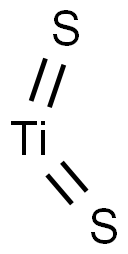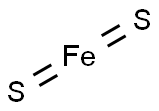TITANIUM(IV) SULFIDE
Synonym(s):Titanium disulphide;Titanium sulfide
- CAS NO.:12039-13-3
- Empirical Formula: S2Ti
- Molecular Weight: 112
- MDL number: MFCD00049598
- EINECS: 234-883-0
- SAFETY DATA SHEET (SDS)
- Update Date: 2024-08-28 13:53:22

What is TITANIUM(IV) SULFIDE?
Chemical properties
yellowish brown powder(s); hexagonal; sensitive to moisture, forming H2S and TiO2; decomposed by steam; is obtained as a product of the reaction of H2S and TiCl4 at 600°C; used as a solid lubricant [HAW93] [STR93] [KIR83]
The Uses of TITANIUM(IV) SULFIDE
Titanium(IV) sulfide is used in solid lubricant, cathode material in rechargeable batteries, corrosion resistance alloys, solid-state lithium batteries, hybrid electric vehicles and plug-in electric vehicles. It is used in the synthesis of nanoclusters, nanodisks and nanotubes. It has high electrical conductivity. Titanium electrodes are used in chloralkali electrolysis, electrodialysis, galvanic technology, light bulbs, and bone pins.
The Uses of TITANIUM(IV) SULFIDE
Solid lubricant.
Definition
Yellow solid. Decomposed by steam.
General Description
A yellow or gray powder with an unpleasant odor that is used as a solid lubricant. Contact with the material may cause burns to skin, eyes, and mucous membranes. TITANIUM(IV) SULFIDE may be toxic by ingestion, inhalation or skin absorption.
Air & Water Reactions
Contact with water leads to the slow evolution of hydrogen sulfide, a toxic and flammable gas.
Reactivity Profile
TITANIUM(IV) SULFIDE reacts with acids to generate hydrogen sulfide, a toxic gas. Reacts slowly with water and is decomposed by steam, generating hydrogen sulfide.
Health Hazard
Fire will produce irritating, corrosive and/or toxic gases. Inhalation of decomposition products may cause severe injury or death. Contact with substance may cause severe burns to skin and eyes. Runoff from fire control may cause pollution.
Fire Hazard
Flammable/combustible material. May ignite on contact with moist air or moisture. May burn rapidly with flare-burning effect. Some react vigorously or explosively on contact with water. Some may decompose explosively when heated or involved in a fire. May re-ignite after fire is extinguished. Runoff may create fire or explosion hazard. Containers may explode when heated.
Properties of TITANIUM(IV) SULFIDE
| Density | 3,37 g/cm3 |
| RTECS | XR2460000 |
| solubility | soluble in HSO4 |
| form | Powder |
| Specific Gravity | 3.22 |
| color | yellow to brown |
| Water Solubility | Titanium(IV) sulfide is insoluble in water and moderately acid soluble. |
| Sensitive | Moisture Sensitive |
| CAS DataBase Reference | 12039-13-3(CAS DataBase Reference) |
| EPA Substance Registry System | Titanium sulfide (TiS2) (12039-13-3) |
Safety information for TITANIUM(IV) SULFIDE
| Signal word | Warning |
| Pictogram(s) |
 Flame Flammables GHS02  Exclamation Mark Irritant GHS07 |
| GHS Hazard Statements |
H252:Self-heating substances and mixtures H315:Skin corrosion/irritation H319:Serious eye damage/eye irritation H335:Specific target organ toxicity, single exposure;Respiratory tract irritation |
| Precautionary Statement Codes |
P235:Keep cool. P302+P352:IF ON SKIN: wash with plenty of soap and water. P305+P351+P338:IF IN EYES: Rinse cautiously with water for several minutes. Remove contact lenses, if present and easy to do. Continuerinsing. |
Computed Descriptors for TITANIUM(IV) SULFIDE
| InChIKey | CFJRPNFOLVDFMJ-UHFFFAOYSA-N |
New Products
4-AMINO-TETRAHYDRO-PYRAN-4-CARBOXYLIC ACID HCL 4-(Dimethylamino)tetrahydro-2H-pyran-4-carbonitrile 4-Aminotetrahydropyran-4-carbonitrile Hydrochloride (R)-3-Aminobutanenitrile Hydrochloride 3-((Dimethylamino)methyl)-5-methylhexan-2-one oxalate 1,4-Dioxa-8-azaspiro[4.5]decane 5-Bromo-2-nitropyridine Nimesulide BP Aceclofenac IP/BP/EP Diclofenac Sodium IP/BP/EP/USP Mefenamic Acid IP/BP/EP/USP Ornidazole IP Diclofenac Potassium THOMAIND PAPER PH 2.0 TO 4.5 1 BOX BUFFER CAPSULE PH 9.2 - 10 CAP SODIUM CHLORIDE 0.1N CVS ALLOXAN MONOHYDRATE 98% PLATINUM 0.5% ON 3 MM ALUMINA PELLETS (TYPE 73) LITHIUM AAS SOLUTION 2-Bromo-1-(bromomethyl)-3-chloro-5-nitrobenzene 2-Bromo-3-nitroaniline N-(3-Hydroxypropyl)-N-methylacetamide 3-Bromo-6-chloropyridazine 4-ethyl-3-nitrobenzoic acidRelated products of tetrahydrofuran








You may like
-
 Titanium(IV) Sulfide CAS 12039-13-3View Details
Titanium(IV) Sulfide CAS 12039-13-3View Details
12039-13-3 -
 Titanium(IV) sulfide CAS 12039-13-3View Details
Titanium(IV) sulfide CAS 12039-13-3View Details
12039-13-3 -
 1823368-42-8 98%View Details
1823368-42-8 98%View Details
1823368-42-8 -
 2-(3-(tert-butyl)phenoxy)-2-methylpropanoic acid 1307449-08-6 98%View Details
2-(3-(tert-butyl)phenoxy)-2-methylpropanoic acid 1307449-08-6 98%View Details
1307449-08-6 -
 Ethyl 3-(furan-2-yl)-3-hydroxypropanoate 25408-95-1 98%View Details
Ethyl 3-(furan-2-yl)-3-hydroxypropanoate 25408-95-1 98%View Details
25408-95-1 -
 2-Chloro-5-fluoro-1-methoxy-3-methylbenzene 98%View Details
2-Chloro-5-fluoro-1-methoxy-3-methylbenzene 98%View Details
1805639-70-6 -
 1784294-80-9 98%View Details
1784294-80-9 98%View Details
1784294-80-9 -
 Lithium ClavulanateView Details
Lithium ClavulanateView Details
61177-44-4